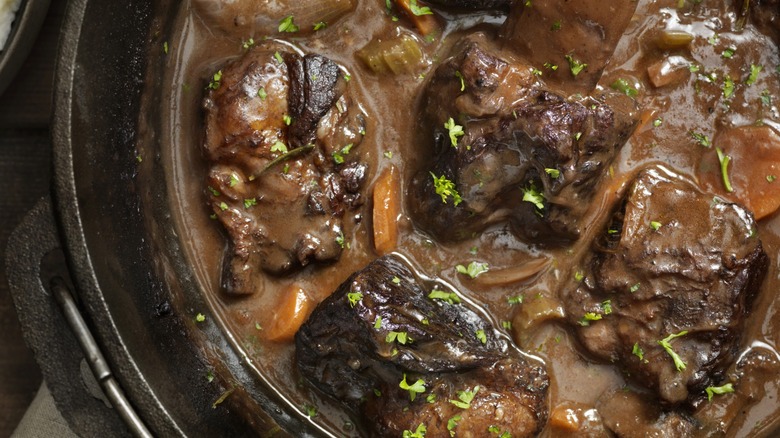For Richer Beef Stew, Short Ribs Are The Chef-Approved Cut To Use
The best kinds of recipes are the ones where there are no rules, and beef stew is proof of that concept. Of course, there is one basic guideline: Beef stew has beef in it. But beyond that, the mix of flavors, aromatics, additions, and spices is totally up to you. Prefer a hearty beef stew filled with root vegetables and potatoes? Go wild. Or, go completely addition-free and make a bowl of old-fashioned Texas Red. How about incorporating some red wine, beer, or sherry? Nobody is going to stop you or tell you that you're wrong.
So, what will people find fault with in your beef stew? If it's too thin and lacking in rich beef flavor, and if those chunks of beef aren't tender enough to give way the second you bite into them, your stew will be considered lacking. So, for a tip on how to make the best beef stew, Tasting Table reached out to Chef John Politte, the owner and executive chef of the YouTube series "It's Only Food," to ask what cuts of beef he prefers to use in his beef stew.
Chef Politte told us he prefers two specific cuts, saying, "For a rich beef stew, I like oxtails or beef short ribs." As for why he prefers those two choices over more classic American beef stew options like chuck, he explained that "The added bone marrow and collagen give the meat an extra special flavor and texture when slow cooked in a stew."
Short ribs give your beef stew extra flavor and a silky texture
In any beef stew recipe, you are looking for a cut that has a good amount of fat and connective tissue, because fat is flavor and connective tissue breaks down into gelatin, which can help make your meat stock more thick and luscious. Beef short ribs have both of these things in spades, but bone-in cuts add to that even more, as the extra collagen in the bone will melt into even more gelatin as it cooks. That means even more body — and a rich sheen that anyone who loves beef stew knows is one of the essential signs of a great recipe.
And it's not just about texture, either. While you might think bones are mostly flavorless, the marrow within them is an incredibly rich umami bomb that is almost 80% fat. This amplifies the meaty flavor of the stew and adds an incredible depth that you can't get with just chunks of meat. After all, there is a reason bone broth is so popular.
Short ribs should adapt to any of your favorite beef stew recipes well, but one thing to note is that because of how much connective tissue and fat they have, they may take a while longer to get tender compared to a cut like chuck. So, give your stew plenty of time — at least two hours — to make sure the ribs properly break down. But once you taste a short rib beef stew, you'll realize that the extra time is worth it.

